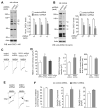Regulation of N-methyl-D-aspartate receptors by disrupted-in-schizophrenia-1
- PMID: 23906531
- PMCID: PMC3864617
- DOI: 10.1016/j.biopsych.2013.06.009
Regulation of N-methyl-D-aspartate receptors by disrupted-in-schizophrenia-1
Abstract
Background: Genetic studies have implicated disrupted-in-schizophrenia-1 (DISC1) as a risk factor for a wide range of mental conditions, including schizophrenia. Because N-methyl-D-aspartate receptor (NMDAR) dysfunction has been strongly linked to the pathophysiology of these conditions, we examined whether the NMDAR is a potential target of DISC1.
Methods: DISC1 was knocked down with a small inference RNA. NMDAR-mediated currents were recorded and NMDAR expression was measured.
Results: We found that cellular knockdown of DISC1 significantly increased NMDAR currents in cortical cultures, which were accompanied by an increase in the expression of NMDAR subunit, GluN2A. NMDAR-mediated synaptic response in prefrontal cortical pyramidal neurons was also increased by DISC1 knockdown in vivo. The effect of DISC1 knockdown on NMDAR currents in cortical cultures was blocked by protein kinase A (PKA) inhibitor, occluded by PKA activator, and prevented by phosphodiesterase 4 inhibitor. Knockdown of DISC1 caused a significant increase of cyclic adenosine monophosphate response element-binding protein (CREB) activity. Inhibiting CREB prevented the DISC1 deficiency-induced increase of NMDAR currents and GluN2A clusters.
Conclusions: Our results suggest that DISC1 exerts an important impact on NMDAR expression and function through a phosphodiesterase 4/PKA/CREB-dependent mechanism, which provides a potential molecular basis for the role of DISC1 in influencing NMDAR-dependent cognitive and emotional processes.
Keywords: CREB; DISC1; GluN2A; NMDA receptors; PKA; schizophrenia.
Copyright © 2014 Society of Biological Psychiatry. Published by Elsevier Inc. All rights reserved.
Figures






Comment in
-
DISC1 dynamically regulates synaptic N-methyl-D-aspartate responses in excitatory neurons.Biol Psychiatry. 2014 Mar 1;75(5):348-50. doi: 10.1016/j.biopsych.2013.12.003. Epub 2013 Dec 16. Biol Psychiatry. 2014. PMID: 24507569 No abstract available.
References
-
- Millar JK, Wilson-Annan JC, Anderson S, Christie S, Taylor MS, Semple CA, Devon RS, Clair DM, Muir WJ, Blackwood DH, Porteous DJ. Disruption of two novel genes by a translocation co-segregating with schizophrenia. Hum Mol Genet. 2000;9:1415–23. - PubMed
-
- Clapcote SJ, Lipina TV, Millar JK, Mackie S, Christie S, Ogawa F, Lerch JP, Trimble K, Uchiyama M, Sakuraba Y, Kaneda H, Shiroishi T, Houslay MD, Henkelman RM, Sled JG, Gondo Y, Porteous DJ, Roder JC. Behavioral phenotypes of Disc1 missense mutations in mice. Neuron. 2007;54:387–402. - PubMed
-
- Hikida T, Jaaro-Peled H, Seshadri S, Oishi K, Hookway C, Kong S, Wu D, Xue R, Andradé M, Tankou S, Mori S, Gallagher M, Ishizuka K, Pletnikov M, Kida S, Sawa A. Dominant-negative DISC1 transgenic mice display schizophrenia-associated phenotypes detected by measures translatable to humans. Proc Natl Acad Sci U S A. 2007;104:14501–14506. - PMC - PubMed
Publication types
MeSH terms
Substances
Grants and funding
LinkOut - more resources
Full Text Sources
Other Literature Sources

